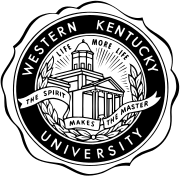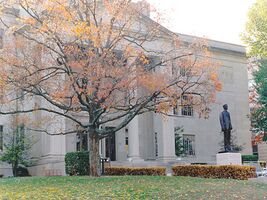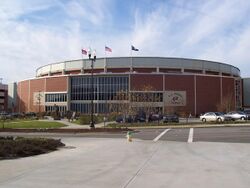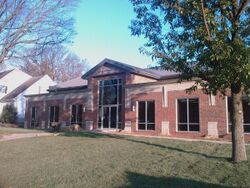Western Kentucky University
Topic: Organization
 From HandWiki - Reading time: 10 min
From HandWiki - Reading time: 10 min
 | |
Former names | Western Kentucky State Normal School (1906–1922) Western Kentucky State Normal School and Teachers College (1922–1930) Western Kentucky State Teachers College (1930–1948) Western Kentucky State College (1948–1966) |
|---|---|
| Motto | The Spirit makes the Master Life more life |
| Type | Public university |
| Established | 1906 |
Academic affiliations |
|
| Endowment | $209.5 million (2022)[1] |
| President | Timothy C. Caboni |
Academic staff | 932 (658 full-time) (Fall 2020)[2] |
Administrative staff | 1,691 (1,101 full-time) (Fall 2020)[2] |
| Students | 16,495 (Fall 2022)[3] |
| Undergraduates | 14,442 (Fall 2022)[3] |
| Postgraduates | 2,053 (Fall 2022)[3] |
| Location | Bowling Green , Kentucky , United States [ ⚑ ] : 36°59′10″N 86°27′20″W / 36.98611°N 86.45556°W |
| Campus | 200 acres (0.81 km2) |
| |u}}rs | Red and White[4] |
| Nickname | Hilltoppers and Lady Toppers |
Sporting affiliations | NCAA Division I – C-USA |
| Mascot | Big Red |
| Website | www |
 | |
Western Kentucky University is a public university in Bowling Green, Kentucky. It was founded by the Commonwealth of Kentucky in 1906, though its roots reach back a few decades earlier. It operates regional campuses in Glasgow, Elizabethtown-Fort Knox, and Owensboro. The main campus sits atop a hill overlooking the Barren River valley.[5]
History
The roots of Western Kentucky University go back to 1876 with the founding by A. W. Mell of the privately owned Glasgow Normal School and Business College in Glasgow, Kentucky. This moved to Bowling Green in 1884 and became the Southern Normal School and Business College.[6] In 1890, Potter College was opened as a private women's college by Pleasant J. Potter.[7] In 1906, Henry Hardin Cherry sold the Southern Normal School and became president of the Western Kentucky State Normal School,[7] which had just been created by an act of the Kentucky General Assembly. Southern's student body and its building became the new school, with classes beginning on January 22, 1907.[8] In 1909 Potter College closed and Western bought the buildings and property of the school.[9] In 1911, Western relocated to its present site on the property that had been Potter College.[8]
In 1922, the school was authorized by the state to grant four-year degrees and was renamed "Western Kentucky State Normal School and Teachers College".[10] The first four-year degrees were awarded in 1924. In 1927, the school merged with Ogden College, which occupied an adjacent campus. The name changed again in 1930 to "Western Kentucky State Teachers College". The school was authorized to offer the Master of Arts degree in 1931. Another name change took place in 1948 when the school became simply "Western Kentucky State College".
WKSC merged with the Bowling Green College of Commerce, which had formerly been the Bowling Green Business University, in 1963. Bowling Green Business University had originally been a part of the Southern Normal School and had been sold off by Henry Hardin Cherry when Southern Normal School was transferred to the state. The structure of the institution changed at this time, divided into separate colleges. Bowling Green College of Commerce maintained its identity in this way. The Graduate School also became a constituent college. In 1965, three additional colleges were created. In 1966, Western Kentucky State College became Western Kentucky University.
For many years, the college was popularly known as "Western," as indicated in its fight song, "Stand Up and Cheer."[11] However, administrators in recent years have preferred to call it "WKU."[12]
On July 1, 2017, Timothy C. Caboni became the university's 10th president.[13]
Presidents of Western Kentucky University
Western Kentucky University officially lists ten presidents since the formation of the Office of the President.[14]
| No. | Name | Years served | Time as president |
|---|---|---|---|
| 1 | Henry Hardin Cherry | 1906–1937 | 31 years |
| 2 | Paul L. Garrett | 1937–1955 | 18 years |
| 3 | Kelly Thompson | 1955–1969 | 14 years |
| 4 | Dero Downing | 1969–1979 | 10 years |
| 5 | John Minton | 1979 | .5 years |
| 6 | Donald Zacharias | 1979–1985 | 6 years |
| 7 | Kern Alexander | 1986–1988 | 2 years |
| 8 | Thomas Meredith | 1988–1997 | 9 years |
| 9 | Gary Ransdell | 1997–2017 | 20 years |
| 10 | Timothy Caboni | 2017–present | 6 years |
Note: Paul Cook served as interim president from 1985 to 1986
Academics
Western Kentucky University houses five academic colleges, an honors college, and a gradaute school.[15]
- College of Education and Behavioral Sciences
- Ogden College of Science & Engineering
- Potter College of Arts & Letters
- Gordon Ford College of Business
- College of Health and Human Services
- Mahurin Honors College
- The Graduate School

(As of 2007), twenty-seven alumni of WKU's photo and print journalism programs have been awarded thirteen Pulitzer Prizes, including eleven alumni recognized for their coverage of the Carrollton bus crash.[16] The school publishes a twice-weekly newspaper, the College Heights Herald.[17]
Mahurin Honors College
The WKU Honors College became the first Honors College in the Commonwealth of Kentucky on July 1, 2007. The Honors College serves over 1,300 active Honors students with the 2016 incoming freshman class ACT/SAT average ranking among the top 6% in the nation.[18]
Center for Gifted Studies
WKU's Center for Gifted Studies conducts research and provides opportunities for gifted and talented students, educators, and parents.
The Carol Martin Gatton Academy of Mathematics and Science in Kentucky
The Carol Martin Gatton Academy of Mathematics and Science in Kentucky opened in the Fall of 2007. The project is based on the University of North Texas's Texas Academy of Mathematics and Science. The school accepts roughly 100 high school juniors each year. As an incoming juniors, students can earn at least 60 college credit hours during their time at the school. The Gatton Academy was named "America's Best High School" by Newsweek in 2012[19] and 2013.[20] The building, originally designed in 1929, was renovated and expanded by RossTarrant Architects[21] to transform it into the Gatton Academy.
Athletics
The Western Kentucky (WKU) athletic teams are called the Hilltoppers (men's) and Lady Toppers (women's). Their mascot is known as Big Red. The mascot has become one of the most popular characters in collegiate sports, even appearing in a series of ESPN promotions. The university is a member of the NCAA Division I ranks, primarily competing in the Conference USA (C-USA) since the 2014–15 academic year.[22] The Hilltoppers and Lady Toppers previously competed in the Sun Belt Conference from 1982–83 to 2013–14; and in the Ohio Valley Conference (OVC) from 1948–49 to 1981–82.
WKU competes in 16 intercollegiate varsity sports: Men's sports include baseball, basketball, cross country, football, golf, and track & field; while women's sports include basketball, cross country, golf, soccer, softball, tennis, track & field, and volleyball.
Swimming
The WKU swim team, before its suspension after the 2014–15 season, consistently placed in the top 5 in the Mid-Major National Rankings. In 2006 their men were undefeated in dual meets and were Sun Belt Conference Champions. The women won five consecutive championships from 2001 to 2005. In 2005, after 37 years as head coach, coach Bill Powell became an assistant coach, and holds the record for being the second-winningest coach in men's swimming in NCAA dual meet history.
In January 2015, former swimmer Colin Craig told police he had been assaulted and forced to drink alcohol, even though at the time he was too young to buy or drink alcohol. He also reported incidents of hazing at a house near campus. An investigation by police and school officials revealed numerous incidents of drug use and sexually charged hazing dating back to at least 2012. Powell's successor, Bruce Marchionda, was aware of this behavior and did nothing to prevent it, even though it violated university policies on hazing, sexual harassment, and sexual misconduct. One swimmer was charged with possession of marijuana.[23] On April 14, WKU officials announced the swimming and diving program would be suspended for five years due to what former school president Gary Ransdell called a "pervasive" and "intolerable" environment.[24] The program's return after the suspension was placed in serious doubt after WKU officials canceled all funding for the swimming and diving program in 2018 as part of larger budget cuts to the athletic department. According to the Bowling Green Daily News, the program would likely not return in 2020 without "significant" outside donations.[25]
Baseball
The baseball team has enjoyed some success, winning the Sun Belt Conference tournament championship in 2009. In April 2010, the WKU baseball team defeated the University of Kentucky 24–8 in a game at Bowling Green Ballpark. The crowd of 6,183 was the largest crowd to ever attend a college baseball game in the Commonwealth of Kentucky.[citation needed]
Basketball
The men's basketball program claims to have the 14th most victories in the history of the NCAA.
The men's basketball team defeated Middle Tennessee in the 2008 Sun Belt Conference tournament championship game to get a bid into the 2008 NCAA Tournament. The Hilltoppers won their first-round contest against Drake on a last-second three-pointer by Ty Rogers, and won their second-round game against San Diego, before losing by 2 points against UCLA in the Sweet 16. It was the Toppers' third appearance in the Sweet 16 but their first since 1993. In 2009, the men's basketball team defeated Illinois in the first round of the NCAA Tournament to advance to the second-round game against Gonzaga. Unfortunately, the Toppers were beaten by a last-second shot, failing to advance to their second straight Sweet 16. In the first round of the NCAA Tournament in 2012, the Toppers pulled off a stunning win against Mississippi Valley State, erasing a 16-point deficit with less than five minutes left and pulling off the 59–58 win while President Barack Obama and British Prime Minister David Cameron looked on.
Michelle Clark-Heard is the current women's basketball coach at Western Kentucky.
Football
The Hilltopper football team belonged to what was then the Gateway Football Conference until 2006. In 2002, WKU won the NCAA Division I FCS National Football championship. In 2006, the school's board of regents voted to move the team to the Division I Bowl Subdivision (formerly I-A). After two years of provisional status, they began to compete in 2009 as a member of the Sun Belt Conference. An extensive rivalry with Eastern Kentucky University, known as the Battle of the Bluegrass, ended in 2008 as WKU moved into FBS football. The Hilltoppers' biggest Sun Belt rivals had been the Middle Tennessee Blue Raiders, who are less than two hours away from WKU. The rivalry was temporarily halted in 2013 after Middle Tennessee left the Sun Belt for C-USA but was renewed the following year when WKU moved to C-USA. The Hilltoppers are coached by head coach Tyson Helton
Greek organizations
| Race and ethnicity[26] | Total | ||
|---|---|---|---|
| White | 78% | ||
| Black | 10% | ||
| Hispanic | 4% | ||
| Other[lower-alpha 1] | 4% | ||
| Asian | 2% | ||
| Foreign national | 2% | ||
| Economic diversity | |||
| Low-income[lower-alpha 2] | 39% | ||
| Affluent[lower-alpha 3] | 61% | ||
In 1965 the Western Kentucky University Board of Regents allowed national fraternities and sororities to form local chapters. Currently, there are some 33 active organizations with approximately 1,500 active undergraduates.[27]
Media and publications
- College Heights Herald, WKU's student-run newspaper since 1924
- Talisman,[28] WKU's yearbook
- Rise Over Run Magazine, WKU's online magazine for independent culture
- WKU SPIRIT, WKU's alumni magazine, published three times each year
- WWHR, Revolution 91.7 – WKU's college radio station
- WKU NewsChannel 12 – Student-run television newscast. On campus cable channel 12 on Tuesdays and Wednesdays. Re-broadcast on university-owned PBS member station WKYU at the end of their broadcasting day.
- The Extra Point – Student-run television sportscast. This 30-minute show airs on campus cable channel 12 on Thursdays when school is in session. Airs live at 6 and re-airs at the end of the WKYU broadcast day.
Agreement with the University of Akureyri
In 2015, Western Kentucky University (WKU), the University of Akureyri (UNAK) and the Icelandic Arctic Cooperation Network (IACN) signed an academic and research agreement that solidifies the North Atlantic Climate Change Collaboration (NAC3) project.
The NAC3 project focuses on academic exchange, course development, and collaborative research in climate change, climate literacy, health and wellness, ocean dynamics, sustainability, informal public education, economic development, technology exchange, and water resources, among others.[29]
Notable people
Notes
References
- ↑ As of June 30, 2022. U.S. and Canadian Institutions Listed by Fiscal Year (FY) 2022 Endowment Market Value and Change in Endowment Market Value from FY21 to FY22 (Report). National Association of College and University Business Officers and TIAA. June 30, 2022. https://www.nacubo.org/-/media/Nacubo/Documents/research/2022-NTSE-Public-Tables--Endowment-Market-Values--FINAL.ashx. Retrieved June 20, 2023.
- ↑ 2.0 2.1 "Employees by Type and Status: WKU Factbook (2020)". Western Kentucky University. https://www.wku.edu/instres/fact_book.php.
- ↑ 3.0 3.1 3.2 "CPE Interactive Data Center". https://reports.ky.gov/t/CPE/views/KentuckyPostsecondaryEducationInteractiveDataDashboard/Navigation?%3AshowAppBanner=false&%3Adisplay_count=n&%3AshowVizHome=n&%3Aorigin=viz_share_link&%3AisGuestRedirectFromVizportal=y&%3Aembed=y.
- ↑ WKU Communication & Branding Manual. https://www.wku.edu/marketingandcommunications/documents/communication_branding_manual.pdf. Retrieved March 25, 2016.
- ↑ Switzer, The Daily News, Liz (May 4, 2010). "WKU officials dedicate newly renovated Preston Center" (in en). https://www.bgdailynews.com/news/wku-officials-dedicate-newly-renovated-preston-center/article_4c56ed3e-4151-59fd-864a-2ac93567fd65.html.
- ↑ Ellis 2011, p. 137.
- ↑ 7.0 7.1 Ellis 2011, p. 363.
- ↑ 8.0 8.1 "The History of WKU". Bowling Green, Kentucky: Western Kentucky University. 2011. http://www.wku.edu/wkuhistory/.
- ↑ Ellis 2011, p. 365.
- ↑ "History of Western Kentucky University". http://www.wku.edu/library/dlsc/ua/wkuhist.htm.
- ↑ Tradition page at WKU athletic site
- ↑ "2012–13 men's basketball media guide". http://grfx.cstv.com/photos/schools/wky/sports/m-baskbl/auto_pdf/2012-13/misc_non_event/2013-mg.pdf.
- ↑ "WKU President Timothy C. Caboni". http://www.wku.edu/caboni/.
- ↑ "WKU Timeline". https://digitalcommons.wku.edu/wku_timeline/.
- ↑ "Academics | Western Kentucky University". https://www.wku.edu/academics/.
- ↑ "WKU News & Events". wku.edu. http://www.wku.edu/news/releases04/october/pulitzer.html.
- ↑ Herald, College Heights. "wkuherald.com | Campus News, Sports & Breaking News from Western Kentucky University | WKU Herald". https://wkuherald.com/.
- ↑ klk62361. "Honors College Home". Western Kentucky University. http://www.wku.edu/honors.
- ↑ "America's Best High Schools 2012". Newsweek. http://www.newsweek.com/2012/05/20/america-s-best-high-schools.html.
- ↑ "2013 America's Best High Schools". Newsweek. http://www.newsweek.com/2013/05/06/america-s-best-high-schools.html.
- ↑ "RossTarrant Architects – Enhancing Education Through Great Design". RossTarrant Architects. September 7, 2023. https://www.rosstarrant.com/test2/.
- ↑ "WKU Enters Athletic Membership Agreement with Conference USA Beginning July 1, 2014 - Western Kentucky University Official Athletics Site". Wkusports.com. http://www.wkusports.com/ViewArticle.dbml?DB_LANG=C&DB_OEM_ID=5400&ATCLID=207019336.
- ↑ Highland, Deborah (April 15, 2015). "WKU swim program suspended for five years in wake of hazing investigation". Bowling Green Daily News. http://www.bgdailynews.com/news/wku-swim-program-suspended-for-five-years-in-wake-of/article_26df8e00-e2a7-11e4-8849-1f04b5a1dc98.html.
- ↑ "WKU Suspends Swimming and Diving Program for 5 Years" (Press release). WKU Athletics. April 14, 2015. Archived from the original on April 17, 2015. Retrieved April 15, 2015.
- ↑ Brad Stephens (June 26, 2018). "Funding eliminated for WKU's swimming and diving program". Bowling Green Daily News. https://www.bgdailynews.com/sports/wku/funding-eliminated-for-wku-s-swimming-and-diving-program/article_06fc5e77-ecbf-550d-a975-fd6833b16acd.html.
- ↑ "College Scorecard: Western Kentucky University". United States Department of Education. https://collegescorecard.ed.gov/school/?157951-Western-Kentucky-University.
- ↑ "Western Kentucky University Greek Affairs – About". http://www.wkugreeks.com/about.
- ↑ "WKU Talisman" (in en-US). https://www.wku.edu/talisman/.
- ↑ "WKU extends international reach with partnership in Iceland" (in en). March 23, 2015. https://wkunews.wordpress.com/2015/03/23/iceland-agreement/.
Bibliography
- Ellis, William E. (2011). A History of Education in Kentucky. Lexington, Kentucky: University Press of Kentucky. ISBN 978-0-8131-4023-0. https://books.google.com/books?id=NigFCeHbpvIC&pg=PT137.
External links
 |
 KSF
KSF





